Difference between revisions of "Infrastructure"
From Immersive Visualization Lab Wiki
(→Virtulab) |
|||
| Line 7: | Line 7: | ||
</tr> | </tr> | ||
</table> | </table> | ||
| − | |||
| − | |||
===NexCAVE=== | ===NexCAVE=== | ||
| Line 19: | Line 17: | ||
</tr> | </tr> | ||
</table> | </table> | ||
| + | |||
| + | ===TourCAVE=== | ||
| + | <table border=1> | ||
| + | <tr> | ||
| + | <td valign="top">[[Image: TourCAVE.jpg]]</td> | ||
| + | <td valign="top"> | ||
| + | NexCAVE: The NexCAVE was inspired by Calit2’s StarCAVE virtual reality environment and designed and developed by Calit2 Research Scientist Tom DeFanti, Virtual Reality Design Engineer Greg Dawe, Research Scientist Jürgen Schulze and Visualization Specialist Andrew Prudhomme. The Calit2 NexCAVE includes 10 JVC xpol (cross polarized) panels, arranged into three columns, and produces data resolution close to human visual acuity (defined as “20/20 vision”). The Calit2 NexCAVE has an effective resolution of 6,000 x 1,500 pixels per eye, while the full 21-panel, 7-column KAUST version has an effective resolution of 15,000 x 1,500 pixels per eye. The JVC HDTV xpol panels are very bright, which means that, unlike the StarCAVE, it can be used under normal room light levels. The NexCAVE is powered by five Intel quad core Dell XPS computers running under [http://www.rocksclusters.org ROCKS/CentOS], with dual Nvidia 285 graphics cards, with an additional XPS machine as the head node to control the rendering cluster. For user tracking and interaction, we use a wireless, optical tracking system by [http://ar-tracking.eu ART]. It consists of two IR cameras and a wireless Saitek game pad with a tracking target. We currently support two software environments to drive the NexCAVE: [http://www.hlrs.de/organization/vis/covise/ COVISE] and [http://ivl.calit2.net/wiki/index.php/CalVR CalVR].</td> | ||
| + | </tr> | ||
| + | </table> | ||
| + | |||
| + | ===VRoom=== | ||
===Virtulab=== | ===Virtulab=== | ||
| Line 40: | Line 49: | ||
</tr> | </tr> | ||
</table> | </table> | ||
| − | |||
| − | |||
| − | |||
===Digital Theater=== | ===Digital Theater=== | ||
Revision as of 00:23, 3 March 2012
Contents |
StarCAVE
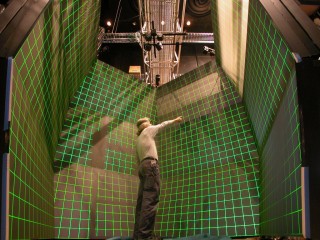 |
The StarCAVE consists of five walls with three screens each, plus floor projection. Two JVC HD2K projectors generate a stereo image for each screen, plus four projectors for the floor, totalling 34 projectors. Every projector pair is driven by a Dell XPS computer running under ROCKS/CentOS, with dual Nvidia Quadro 5600 graphics cards. We use an additional XPS machine as the head node to control the rendering cluster, for a total of 18 nodes. For user tracking and interaction we use a wireless, optical tracking system by ART Tracking. It consists of four IR cameras and a Flystick2 3D joystick. We currently support two software environments to drive the StarCAVE: CalVR and COVISE. The StarCAVE is located on the first floor of Atkinson Hall in room 1608a and can be booked on recharge. |
NexCAVE
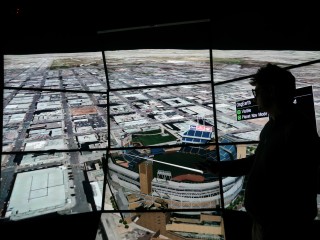 |
NexCAVE: The NexCAVE was inspired by Calit2’s StarCAVE virtual reality environment and designed and developed by Calit2 Research Scientist Tom DeFanti, Virtual Reality Design Engineer Greg Dawe, Research Scientist Jürgen Schulze and Visualization Specialist Andrew Prudhomme. The Calit2 NexCAVE includes 10 JVC xpol (cross polarized) panels, arranged into three columns, and produces data resolution close to human visual acuity (defined as “20/20 vision”). The Calit2 NexCAVE has an effective resolution of 6,000 x 1,500 pixels per eye, while the full 21-panel, 7-column KAUST version has an effective resolution of 15,000 x 1,500 pixels per eye. The JVC HDTV xpol panels are very bright, which means that, unlike the StarCAVE, it can be used under normal room light levels. The NexCAVE is powered by five Intel quad core Dell XPS computers running under ROCKS/CentOS, with dual Nvidia 285 graphics cards, with an additional XPS machine as the head node to control the rendering cluster. For user tracking and interaction, we use a wireless, optical tracking system by ART. It consists of two IR cameras and a wireless Saitek game pad with a tracking target. We currently support two software environments to drive the NexCAVE: COVISE and CalVR. |
TourCAVE
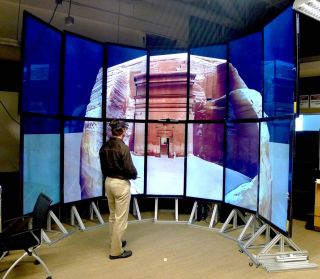 |
NexCAVE: The NexCAVE was inspired by Calit2’s StarCAVE virtual reality environment and designed and developed by Calit2 Research Scientist Tom DeFanti, Virtual Reality Design Engineer Greg Dawe, Research Scientist Jürgen Schulze and Visualization Specialist Andrew Prudhomme. The Calit2 NexCAVE includes 10 JVC xpol (cross polarized) panels, arranged into three columns, and produces data resolution close to human visual acuity (defined as “20/20 vision”). The Calit2 NexCAVE has an effective resolution of 6,000 x 1,500 pixels per eye, while the full 21-panel, 7-column KAUST version has an effective resolution of 15,000 x 1,500 pixels per eye. The JVC HDTV xpol panels are very bright, which means that, unlike the StarCAVE, it can be used under normal room light levels. The NexCAVE is powered by five Intel quad core Dell XPS computers running under ROCKS/CentOS, with dual Nvidia 285 graphics cards, with an additional XPS machine as the head node to control the rendering cluster. For user tracking and interaction, we use a wireless, optical tracking system by ART. It consists of two IR cameras and a wireless Saitek game pad with a tracking target. We currently support two software environments to drive the NexCAVE: COVISE and CalVR. |
VRoom
Virtulab
| The Virtulab is a dynamic visualization laboratory, which currently houses the TourCAVE, the REVE, and a LifeSize video-teleconferencing (VTC) device. Funded by a special partnership with King Abdullah University of Science and Technology (KAUST), the Virtulab serves as a working prototype/research environment for many KAUST visualization areas. Collaboration between Calit2 scientists at UC San Diego, the Electronic Visualization Laboratory (EVL) at the University of Illinois at Chicago, and KAUST allows for ongoing research in 2D, 3D, and auto-stereo visualization. The Virtulab also serves as a prime testing environment for CineGrid and ON*VECTOR networking and 4K experiments. | |
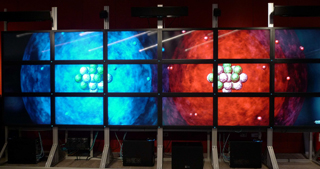 |
REVE: The Rapidly Expandable Virtual Environment (REVE) uses lenticular screens to present limited-depth auto-stereoscopic images to viewers without the use of any glasses. The REVE at Calit2 is made up of 6 tiled (3 panels x 2 panels) Alioscopy high-definition displays, where tiling the displays helps to make up for loss of resolution inherent in the auto-stereo presentation. The REVE multiplexes 8 views, and it has multiple "sweet spots", which makes it ideal for small group viewing. The REVE is powered by 4 HP XW8600 computers, which makes up the 3 nodes (each node runs two displays, or one column) and one head node. Each node has dual GTX280 NVIDIA graphics cards, and allocates one graphics card per display. |
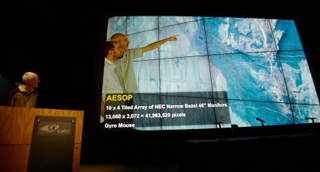 |
CineGrid and ON*VECTOR Networking and 4K Experiments: The Virtulab is also a prime staging and testing environment for CineGrid and ON*VECTOR 4K networking experiments. The Virtulab utilizes 3DTV displays and a JVC 4K projector. Data can also be moved to the Calit2 Auditorium or Theater for additional 4K testing. |
Digital Theater
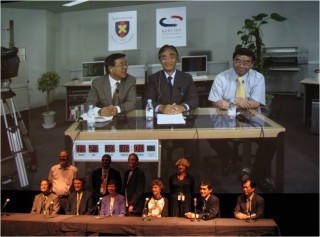 |
Calit2's digital theater offers 200 seats with power and ethernet jacks in every seat. The high end technical equipment installed in this room allows it to be used for anything ranging from presentations with Powerpoint slides, video screenings, presentations of visual and performance art, to demonstrations of the future of digital cinema: 4k video on a 18 by 32 foot screen. Among the technical highlights of the auditorium are: a 20 channel surround sound system, high definition (HD) video playback from computers or digital HD tapes, real-time virtual reality with a 3D tracking system, and a Sony SRXD-R110 4k projector (4096x2160 pixels resolution). The control room houses the following 4k-relevant hardware:
Other equipment used in the digital theater includes a digital light mixer, a conventional projector by Christie with a resolution of 1600x1200 pixels, and a remote control system by Crestron which allows presenters to connect their laptops and control video and audio directly from the podium. |